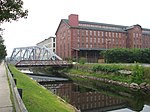Spicket River
Essex County, Massachusetts geography stubsLawrence, MassachusettsMassachusetts river stubsMethuen, MassachusettsNew Hampshire river stubs ... and 5 more
Rivers of Essex County, MassachusettsRivers of MassachusettsRivers of New HampshireRivers of Rockingham County, New HampshireTributaries of the Merrimack River

The Spicket River is a 17.7-mile-long (28.5 km) river located in New Hampshire and Massachusetts in the United States. It is a left tributary of the Merrimack River, part of the Gulf of Maine watershed. It is sometimes spelled "Spickett".The Spicket River begins at the outlet of Island Pond in Derry, New Hampshire, and flows south into Salem, New Hampshire, passing through the Arlington Mill Reservoir. The river continues through Salem, encountering copious suburban development, and enters the city of Methuen, Massachusetts, where it drops nearly 100 feet (30 m) in elevation over a series of dams on its way to the Merrimack River in Lawrence.
Excerpt from the Wikipedia article Spicket River (License: CC BY-SA 3.0, Authors, Images).Spicket River
Marston Street, Lawrence
Geographical coordinates (GPS) Address Nearby Places Show on map
Geographical coordinates (GPS)
| Latitude | Longitude |
|---|---|
| N 42.706111111111 ° | E -71.146388888889 ° |
Address
Merrimack Medical Center and Walk In
Marston Street 25
01842 Lawrence
Massachusetts, United States
Open on Google Maps










